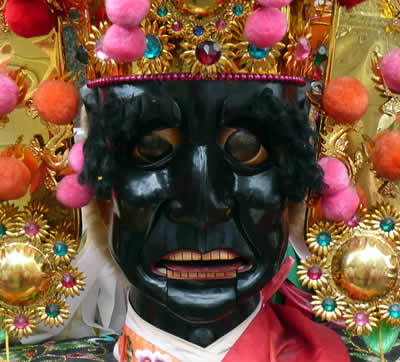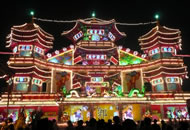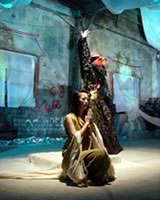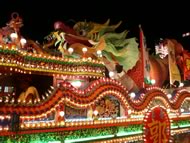 |
 |
 |
|
News & Notices
News From:
Commissions
Conference & Stage Expo
For the Record
 |
The large puppet, at left, was part of a parade experienced by participants in the Asian Ritual Festival Workshop. OISTAT sponsored the 11-day workshop in Taipei, Taiwan. Photo/Sandy Bonds |
|
|
From Ritual to Theatre:
OISTAT's Asian Workshop
In Taoist practice, during the seventh month of each lunar year, the gates of the underworld swing open and the ghosts are free to wander among the living world. Ceremonies are held to both welcome the ghosts and provide for their needs, while discouraging them from staying longer than the month-long celebrations. In August, OISTAT, now with its office located in Taipei, Taiwan, organized an event to introduce the Ghost Festival to theatre practitioners from around the world and to engender conversations about the interconnections between theatre and ritual heritages. Among the international participants who met in Taipei were Maija Pekkanen, former OISTAT President from Finland; Dorita Hannah, an architect and scenographer from New Zealand; and Pamela Howard, now retired from Central St. Martin's College of Art & Design, and initiator of the Scenofest held in conjunction with the Prague Quadrennial. USITT members attending the workshop were Cathie McClellan, costume designer and department chair of Theatre Arts at the University of the Pacific, and Connie Strayer, costume designer for Stanford University and union makeup artist, and Alexandra Bonds, costume designer for University of Oregon and USITT Vice-President for International Activities. They were joined by a selection of talented Taipei theatre and dance professionals, as well as a number of students from the area, making the workshop a valuable interaction between local and international artists.
A second excursion took the group to Hsin Zhu to explore an exhibition of paper artwork including a demonstration of how to make the paper figures used in the rituals. Hung Hsin-Fu, a paper sculptor, described his life-long work in paper sculpture, with examples of his beautifully detailed masks, pop-up books, and animated toys on display in the gallery. The workshop then traveled to the center of the city to view the street parade of ceremonial puppets from the local temples. Each temple has eight super puppets representing important figures in the religion, and they are incorporated into the various celebratory events. In addition, the parades feature palanquins carrying god-images, and with some temple groups, the members of the traditional opera troupe march along the route as well.
The workshop participants were then organized into five teams and each was charged with creating, in the remaining few days, a design as performance response to reflect upon the events they had experienced. Each production team consisted of at least one international artist, one Taiwan artist, and several of the students. Ms. McClellan described the process: "Quick! In five days, plan, design, build, and perform a 15-minute production, working in collaboration with other artists and students, based on three days' joint observations of a series of unique cultural events, and do it in a major metropolitan city far from home with no idea of where to find anything.
With the mixture of specialties, talents, and cultural backgrounds the results were as stimulating as they were varied. A performance was held on the final night of the workshop for an audience of about 100 people, including the Director of the Third Department, Tsai-Lang Huang, one of the generous sponsors of the workshop. Ms. Strayer remarked, "This was a rare opportunity to experience not only an aspect of Taiwanese culture, but to collaborate with other international artists to create unique responses, reactions, and interpretations of the Ghost Festival ritual. There was a certain performance vocabulary that allowed us to transcend language, culture, and religious beliefs and focus on ideas, images, and objects that were common to us all." She continued, "Seeing the broad range of 'performances' among the five different groups at the end of the workshop was a rich experience, which was heightened by the strong connection we had all made to the Festival and to other individual artists in the group. It left me with a renewed energy and vision. I'm hoping this kind of international workshop will be considered in other venues as a way to open up ideas and exchanges between not only theatre artists, but to other media artists as well." |
||
United States Institute for Theatre Technology, Inc.:
© 2008 Volume XLVIII, Number 10
 The
11-day workshop from August 13 to 23 began with a field trip
to Keelong, north of Taipei, to visit the Zhu Pa Tan temple,
richly decorated for the festivities. A false façade
was erected in front of the temple with elaborately constructed
paper lanterns of figures and animals. To the right of the
entrance, a stage had been set up for performances of traditional
opera, which are presented for the ghosts and carry on regardless
of whether there are humans in the audience as well. The
courtyard contained several paper houses intended to become
offerings for the ghosts. After dark the parade, sponsored
by 15 of the local clans, began with each presenting a series
of lighted floats, marching bands, costumed dancers, walking
participants, and a paper house to offer to the ghosts.
The
11-day workshop from August 13 to 23 began with a field trip
to Keelong, north of Taipei, to visit the Zhu Pa Tan temple,
richly decorated for the festivities. A false façade
was erected in front of the temple with elaborately constructed
paper lanterns of figures and animals. To the right of the
entrance, a stage had been set up for performances of traditional
opera, which are presented for the ghosts and carry on regardless
of whether there are humans in the audience as well. The
courtyard contained several paper houses intended to become
offerings for the ghosts. After dark the parade, sponsored
by 15 of the local clans, began with each presenting a series
of lighted floats, marching bands, costumed dancers, walking
participants, and a paper house to offer to the ghosts.  As it
was the year of the rat, a surprising number of Mickey Mouse-referenced-images
were presented. Once the parade had concluded, the paper
houses were taken to the waterfront. Each was filled with paper
money inscribed with pictures of items that homeless spirits
might desire -- clothing, food, and shelter. One by one, the
paper lantern houses were launched into the Ba Dou Ze harbor
by a team of swimmers and then set ablaze.
As it
was the year of the rat, a surprising number of Mickey Mouse-referenced-images
were presented. Once the parade had concluded, the paper
houses were taken to the waterfront. Each was filled with paper
money inscribed with pictures of items that homeless spirits
might desire -- clothing, food, and shelter. One by one, the
paper lantern houses were launched into the Ba Dou Ze harbor
by a team of swimmers and then set ablaze.  Back in Taipei,
the members of the workshop were treated to a dress rehearsal
of Mirrors of Life, performed by the Legend Lin Dance Theatre.
Artistic Director Len Lee-Chin uses ritual in her choreography
to reaffirm the cultural characteristics of Taiwan, and this
exquisite and mesmerizing piece of ritual theatre has toured
internationally. The 12-part composition begins in silence,
broken by drumbeats, and then the Goddess Mastu enters to
lead the spirits of the ritual, opening the doorway between
the living and the dead.
Back in Taipei,
the members of the workshop were treated to a dress rehearsal
of Mirrors of Life, performed by the Legend Lin Dance Theatre.
Artistic Director Len Lee-Chin uses ritual in her choreography
to reaffirm the cultural characteristics of Taiwan, and this
exquisite and mesmerizing piece of ritual theatre has toured
internationally. The 12-part composition begins in silence,
broken by drumbeats, and then the Goddess Mastu enters to
lead the spirits of the ritual, opening the doorway between
the living and the dead.  "It
was an explosion of color, sound, smell, taste; in some ways,
an assault on the senses, an immersion into the life and
art of a culture as far removed from anything I have experienced
before as anything could be."
"It
was an explosion of color, sound, smell, taste; in some ways,
an assault on the senses, an immersion into the life and
art of a culture as far removed from anything I have experienced
before as anything could be."